
Duke Ellington. Mary J. Blige. Billy Joel. Vladimir Nabokov. Marilyn Monroe. Vincent Van Gogh. Hans Zimmer. What do these famous artists, musicians, actresses and writers have in common? They all have or had synesthesia.
Synesthesia is defined as a neurological condition wherein “stimulation of one sensory or cognitive pathway leads to automatic, involuntary experiences in a second sensory or cognitive pathway.”
In Zoey Kambour’s ’18 words, “Synesthesia is having one sense also trigger another at the same time. For instance, if you smell something then you might see a color, if you hear something it could taste.”
Kambour, an Art History and Music Performance double major, has a form of synesthesia called chromesthesia.
“I see color when I hear music,” Kambour said. For example, she said that to her, the note C is white, D is blue, E is red, etc.
“Specific keys have their own color, but it doesn’t necessarily match up with a note. A piece will fluctuate in color depending on what it is. For example, Chopin’s ‘Nocturne 27’ fluctuates between pink and purple,” she said.
Kambour first discovered she was a synesthete when she was 18 years old. She had always been able to see color when she heard music, but she didn’t realize other people lacked that ability.
“We were sitting in the car listening to a Miles Davis song on NPR and they were doing an interview with someone who had the same synesthesia condition that I did and my mom was like ‘That would be so cool if you could do that’ and I was like ‘Wait not everyone does that?’ That’s how I figured out,” Kambour said.
As a Music Performance major, having chromesthesia has helped Kambour.
“As a music major, it helps a lot with my intonation. The color will change depending on if I’m on the right key or not, or if I’m singing a note wrong I can see that,” she said.
Kambour’s favorite song to experience color through is “Quem Vidistis,” by Francis Poulenc, which she is currently rehearsing in choir.
“It’s the most gorgeous dark blue with speckles of yellow … it’s so much fun to sing and see that.”
The only downside Kambour ever experiences as a synesthete is when two notes are played a half-step apart.
“I see static … it blurs into my vision, and it’s really stressful,” she said.
Another LC synesthete, Ruby Roll ’19, has color-grapheme and personification synesthesia.
“Letters and numbers have colors and personalities,” Roll explained.
Roll discovered she had synesthesia in middle school.
“I was playing handbell in choir, and then I read a book where one of the characters had synesthesia,” she said.
Similarly to Kambour, Roll described that she can tell what color a number or letter is if it’s written down, but they are different colors in her mind’s eye. As for personality, Roll gave some examples of numbers’ and letters’ personalities:
“One through twelve have personalities. Two and four are really good friends. Two is like a little sister to four. Three has a crush on four, and she’s mean to two. Five and six are really friendly with everybody … seven is a loner, eight is a bully. Q has a personality in relation to P. P wants to be mean to people, and Q stops P from doing that,” Roll said.
However, not every letter has a personality for Roll (though they all have colors), and when she reads a word, certain colors from letters take precedence. For numbers, when she sees a large number, she sees the colors and personalities of each individual number.
“It’s kind of like always having your favorite characters from a book with you,” Roll said.
Ella Santana-Propper ’18, a Biology major, also has color-grapheme synesthesia. For her, “Seven is green, P is blue, A is yellow.”
Santana-Propper was in middle school when she discovered she had synesthesia. Unlike Kambour and Roll, she knows several synesthetes. When she was younger she had a friend who coincidentally had synesthesia, so they would talk about what color numbers and letters were without realizing it was an anomaly.
“It helps me memorize numbers and concepts. Sometimes i can relate things because their colors are kind of similar. It’s always helped with spelling,” she said.
Santana-Propper spoke to how synesthesia has shaped her life.
“It shaped why I came to Lewis & Clark. There was a while where I wanted to study synesthesia. I was originally planning on becoming a neuroscience major, now it’s her minor, because I wanted to study how synesthesia works. I hadn’t thought about that until now.”
Subscribe to the Mossy Log Newsletter
Stay up to date with the goings-on at Lewis & Clark! Get the top stories or your favorite section delivered to your inbox whenever we release a new issue.

Leave a Reply